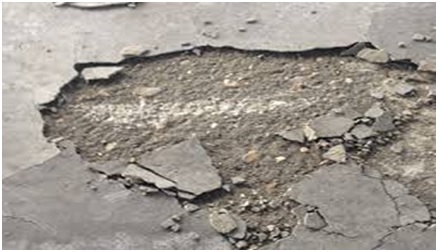Delamination is a mode of failure where a material fractures into layers. A variety of materials including laminate composites and concrete can fail by delamination. When a composite structure is hit, the impact causes shockwaves which travel through the structure, and cause delamination. Delamination reduces the strength of the composite structure and may cause the structure to break at a fraction of the load it would have carried before the impact.
In surface coatings such as paints and films can delaminate from the coated substrate. In laminated composites, the adhesion between layers often fails first causing the layers to separate.

Causes of delamination of concrete
When fresh concrete is placed and compacted, the solids settle. This natural settlement causes excess mix water and entrapped air to be displaced and the lighter materials migrate toward the surface. If finishing operations start prematurely and close or seal the surface before bleeding is completed, air and/or water are trapped under the densified surface mortar.
As concrete hardens, subsurface voids develop where the water or air is trapped. These voids create weakened zones right below the surface that can eventually detach during slab use. Very thin mortar layers over delaminations may even detach when struck with a hammer, as you try to sound out the extent of the delaminated area.
Delaminations are similar to blisters in that delaminated areas of surface mortar result from bleed water and bleed air being trapped below the prematurely closed (densified) mortar surface. The primary cause is finishing the surface before bleeding has occurred. Delaminations are also more likely to occur when factors that extend the bleeding time of concrete (e.g. cold substrate) are combined with factors that accelerate surface setting (e.g. high ambient air temperature). It is necessary to wait for a period of time after placing the concrete to allow air and water to escape from the concrete. The waiting period varies with the concrete mixture, mixing and placing procedures, and weather conditions.
Delaminations are very difficult to detect during finishing and become apparent after the concrete surface has dried and the delaminated area is crushed under traffic. The delaminated mortar thickness ranges from about 3 mm to 5 mm (1/8 in. to 1/4 in.). To avoid conditions that lead to delaminations, see the recommendations under the section on blisters. Delaminations also may be the result of disruptive stresses from chloride-induced corrosion of steel reinforcement or of poorly bonded areas in two-course construction. The resulting delaminations are deeper than those caused by trapped air or bleed water and are often called spalls (see Spalls). A delaminated area that has separated from the underlying concrete can leave a hole in the surface and resembles spalling.
Delamination can occur in:
- Composite materials
- Reinforced concrete structures
- Laminated materials
Delamination tends to destroy a coating’s strength and durability, as well as the material’s aesthetic appearance.
Prevention tips for Delamination of concrete
Greater care in lift placement and consolidation, allowing more time for bleed water to dissipate before closing the surface, proper curing and sealing measures to prevent moisture ingress, and checks to insure minimum concrete cover over steel is provided. Given below are a few tips to avoid defamation.
- The simplest way to prevent delamination is to start final finishing of the slab after the bleeding process has run its course.
- Avoid closing the slab surface too early.
- Take precautions when finishing and check if the concrete is air entrained.
- Avoid finishing slabs placed on impervious surfaces too early.
- Avoid to place concrete on cold subgrades when ground temperatures are below 40°F.
- Warm the concrete or use small doses of set accelerator to promote more uniform setting of the mix.
- Take extra care when ambient evaporative conditions are high and exceed concrete bleeding rates.
- Take measures to counteract rapid evaporative conditions on the jobsite
- Sound the affected area and delineate perimeter.
- Saw- cut perimeter to a minimum deep.
- Chip unsound material down to a minimum depth of beyond the reinforcing.
- Depending on the extent of corrosion, remove, replace, and/or clean, and prep reinforcing steel.
- Saturate surfaces (SSD)
- Apply bond scrub coat
- Patch with a high performance mortar.
- Cure and seal.
Delamination of concrete Resisting testing methods
A delamination survey can be conducted by sounding – dragging a chain across the surface or tapping with a hammer and listening for hollow sounds. A hollow sound indicates delaminated areas, and a ringing sound indicates intact areas. This test is described in ASTM D 4580, Standard Practice for Measuring Delaminations in Concrete Bridge Decks by Sounding. Nonstandard methods for detecting delaminated areas are acoustic impact, infrared thermography, and ground-penetrating radar. Delaminations can be repaired by patching or, if widespread, by grinding and overlaying with a new surface. Epoxy injection may also be beneficial in some applications.
Delamination failure may be detected in the material by its sound:
- Solid composite has a bright sound, while delaminated part sounds dull
- Reinforced concrete sounds solid, whereas delaminated concrete will have a light drum-like sound when exposed to a dragged chain pulled across its surface
Other nondestructive testing methods used include:
- Optical time domain reflectometer testing
- Ultrasound
- Radiographic imaging
- Infrared imaging

